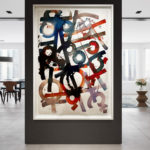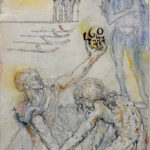BEWARE OF PREDATORY DEALERS
http://www.cnn.com/2009/CRIME/07/14/art.dealer.indicted/index.html

The case is seemingly inconceivable. You have entrusted your artwork, which might as well be a member of your family, to the care of a gallery you trust only to discover that the dealer you are working with is up to no good. The recent indictment of prominent New York dealer Lawrence Salander has thrust predatory dealers into the spotlight and highlighted an unseemly side of the art world that no one really wishes to speak of and fewer wish to believe they could be a victim of… that of civil theft, grand theft and grand larceny by a respected gallery.

New York’s Upper East Side Gallery Salander-OReilly, provided Lawrence Salander, his wife Julie and his family a lavish lifestyle full of the finest cars, luxury homes, food, clothing and an extravagant lifestyle by selling high-end fine art to a distinguished world-wide clientele. A member of the Art Dealers Association of America for over twenty years, Salander-OReilly exhibited at the annual Armory show in New York, Tefaf at Maastricht and Art Basel Miami. Lawrence Salander himself was a member of The Art and Antique Dealers League of America and the Appraisers Association of America. He was the first private art dealer to sit on the board of The National Indemnity Project of The National Endowment for the Humanities. In 2003, Salander-OReilly was named The Best Gallery in the World by the Robb Report.
However, beneath the surface, it is alleged that Salander ran a ponzi scheme (a scheme echoing that of the indicted financier Bernard Madoff) in which he sold consigned works, took the cash, and paid defered payments out to other consignors offering a range of explanations for his actions along the way. His payments snowballed into owing dozens of consignors monthly “dividends” which he would attempt to keep in front of with month-to-month sales. This “dividend” system financed Salander’s extravagant lifestyle, including his Manhattan townhouse, his 66-acre estate home and the lavish parties he threw for his wife and family members, all while he was barely keeping himself afloat in these “dividends”. His investors, including Forbes members, Artists, estates, tennis great John McEnroe and actor Robert DiNiro claim he stole in excess of $88Million through his fraudulent business practices, which included outright theft of artwork, selling “shares” of artworks to multiple people, selling artwork below the promised consignment prices and paying “dividends” to consignors when artwork was already paid in full.
Mr. Salander’s troubles began when several consignors filed lawsuits due to defaulting on the “dividend” payments he promised by specific deadlines. Salander allegedly sold many works by Robert DiNiro Sr. (Father of the actor) without either informing Mr. DiNiro or remitting proceeds for their sale. This was the crux of several of the suits brought against Mr. Salander which amounted to 100 separate counts spanning fraud, grand larceny, securities fraud, forgery, breach of contract and other offenses. The affair become public when London dealer Clovis Whitfield withdrew paintings from a Salander-O’Reilly exhibit because of Salander’s mounting legal troubles. Creditors are said to be owed in excess of $300M and Mr. Salander faces up to 25 years in prison if convicted of grand larceny alone.
[UPDATE: Lawrence Salander, who once peddled Renaissance treasures from his upper East Side townhouse, admitted to 16 grand larceny counts for a promise of no more than six to 18 years in prison. Though bankrupt, he said he will try to repay all his victims the nearly $100M he has admitted stealing. “I am deeply ashamed and sorry for my actions,” Salander, 60, told Manhattan Supreme Court Justice Michael Obus. A Link to Salander’s Plea Arrangement, detailing the types of schemes to defraud which he perpetrated can be found HERE]

This leads to the inevitable question… What can you do to protect yourself?
Well, there are several consumer protections in place which protect buyers and sellers/consignors in the United States. Many states will have laws specific to their borders, but for purposes of this blog, we will utilize Florida statutes and criteria. A useful text is The Artist-Gallery Partnership, by Tad Crawford and Susan Mellon (http://www.amazon.com)
As a seller, artist or consignor: When you consign your artwork to a gallery you have entrusted an asset to another person or company. Just as with other assets, this has certain risks and certain rewards. The reward is obviously that your work is placed with someone who has knowledge and expertise on how best to market and sell your work in the shortest possible time-frame for the most amount of money. Conversely, you run the risk of a predatory gallery selling your work for less than value, not remitting payment according to terms of contract or outright theft.
It is good practice to familiarize yourself with any gallery you are considering consigning works to. Speak with other merchants in and around the gallery you are considering. Contact references, consignors and artists the gallery deals with for impressions on the overall demeanor and temperament toward business practices. Contact the Better Business Bureau (www.bbb.org) or the Florida Department of Agriculture and Consumer Services (www.doacs.state.fl.us/) to determine if any consumer actions have been filed and remain unresolved. Scrutinize your contract and have it reviewed by an attorney.
Once your work is contracted, consigned and in gallery residence, always be certain that your consignment contract is up-to-date with the entity which has physical possession of the artwork if it is not retained by the seller. (Oftentimes, galleries or partnerships are dissolved resulting in contracts being annulled. Among other issues, this may significantly affect insurance coverage in the gallery in the event of something catastrophic occurring to your item). Once a quarter, conduct a physical inspection of your item to make certain it has not been sold without your knowledge. If you are unable to inspect due to distance or infirmity, contact someone you trust locally or the local Sheriff’s office so that they might inspect your item for you. Make certain that offers lower than the contracted price are submitted to you in writing and agreed to in writing and do not agree to deferred payment plans without written assurance that the works will remain in the gallery until you are paid in full for your item. Sometimes even good galleries have difficult time paying the bills in this economic climate. However, you need to do everything possible to prevent your asset from paying only their bills.

Florida statutes state that your consignment contract must provide for:
*The proceeds of the sale must be delivered to the artist (Consignor) at a schedule agreed to by the artist (Consignor) and the art dealer
*The art dealer is responsible for the stated value of the artwork in the event of loss or damage while the artwork is in possession of the art dealer. (See parameters of consignors and galleries under UCC= Uniform Commercial Code Statutes)
*The artwork will only be sold by the art dealer for an amount at least equal to that agreed to by the artist (Consignor) in writing
*The artwork may be used or displayed by the art dealer only with prior written consent of the artist (Consignor) and only if the artist (Consignor) is acknowledged in such use or display
*An artwork delivered to an art dealer for the purpose of sale or exhibition, and the artist’s (Consignor’s) share of the proceeds of any sale by the art dealer, creates a priority in favor of the artist (Consignor) over any claims, liens or security interests in the artwork by creditors of the art dealer
(SOURCE: The Artist-Gallery Partnership, by Tad Crawford) Violations of these rules of conduct are punishable by up to 60 days in jail, six months of probation and a $500 fine for each instance.
[Video detailing the type of difficulties that can result from not having proper documentation for your art consignment can be found HERE]
As a Buyer: Your purchase order is a contract. Make certain that this contract provides you the basic parameters of what, where, how and when. Your purchase order should state the date, the value of the work, the price paid, numbering (if applicable) and the payment terms which have been satisfied at the time of sale. Further, as a buyer you are entitled to any peripheral documentation which quantifies authenticity (i.e. a Certificate of Authenticity, letters of authenticity, appraisals, etc.), condition, value, restoration, international clearance and the like which may exist pertinent to your acquisition.
Oftentimes, the bill of sale or purchase order serves as the certification of an authentic work if the artist is living, the gallery is contracted to work with the artist or the artist has chosen not to issue such certificates In such cases, you may wish to contact the artist or a local expert to determine whether or not the work is genuine. (It is not always in your interest to contact your local art dealer for this determination though as they may or may not have a vested or political interest in whether or not you purchase art from alternate sources).
The proliferation of serialized or limited edition works of art (lithographs, serigraphs, sculptures, documents and signatures) necessitates a need for some form of quantifying document which states the total edition size, the publisher and dates of issue. This certificate has become paramount in determining authorized items from unauthorized items, real from fake and delineations within an artist or celebrity’s oeuvre. While parameters of certificates of authenticity are a lengthy column unto itself, understand that certifications should be arms-length, third party evaluations of the item issued by a publisher, printer, foundry or independent expert on the artist. Galleries should not issue their own authenticity certificates for works published by others, as it is an obvious conflict of interest. Further, your legal ownership of a item is only consummated upon transfer of the original certificate of authenticity as this possession states that the work is paid in full to seller, gallery and other third-parties who may have interest in the work. So always make certain it is obtained, it is correct and it is safely stored.
If you have purchased a limited edition and not received the original certificate with your purchase, it may simply be a matter of contacting the gallery and asking for it. Oftentimes, galleries will keep certifications in separate places in order to protect themselves from theft, fire, flood, etc. However, this document should be readily accessible to the gallery and turned over within a reasonable amount of time. If it is lost, stolen or damaged, galleries can ask for replacements from the publisher provided the work has been purchased and paid for by the gallery. Alternatively, you can also seek outside advise from an expert on the artist or period.
I also recommend artists and consignors consulting a fine art attorney familiar with idiosyncrasies in Art Law pertaining to the state you live in or are releasing your items to. Legal Art is an organization which empowers artists and consignors by offering affordable legal council before, during and after a representation contract or consignment agreement. Their services are highly recommended by professionals in the field as having ethically and judiciously applied their knowledge to the betterment of the Art community as a whole. Kathleen C. Carignan, Esq. is a Miami-based attorney with Legal Art who may provide direction as to who to speak with about any questions particular to your case. (Kathleen@legalartmiami.org- www.legalartmiami.org) Other organizations throughout the United States provide similar services and can be located through a simple GOOGLE search of your area.

In sum total… There is no fool-proof way to avoid being “Salandered”, any more than there is to prevent the onset of “Madoffism”. However, simple steps you take to protect yourself, your assets and your capital can offer small comforts in knowing who, what, when and where of your art investments. This, in turn with pay true “dividends” as you move forward.
NOTICE: I am not an attorney, nor do I claim to be one. This blog is written in to provide common-sense advice for buyers and sellers of fine art, NOT Legal advice. For legal advice, contact an attorney.
All content ©2015 ROBIN RILE FINE ART. Any unauthorized reproduction of images, text or content is strictly prohibited.





